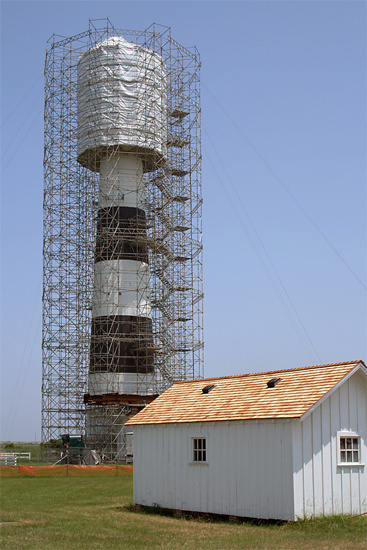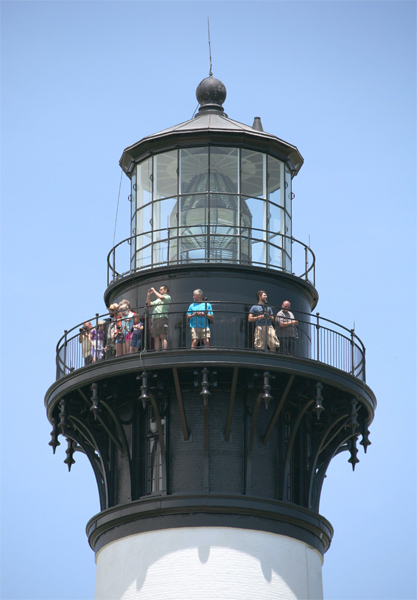Reportedly, Bodie Island, originally “Body,” is named after the family who owned the land, but folklore would have it that the name resulted from the many shipwrecked bodies that washed ashore. Rising 165 feet and painted with striking black and white stripes, picture-perfect Bodie Island Lighthouse is actually the third attempt to illuminate the perilous stretch of coast between Cape Hatteras and Currituck Beach.
|
In 1838, Congress modified the wording of its 1837 appropriation so it would apply to a lighthouse on “Body's Island” as well, but the construction of the lighthouse was fraught with problems, beginning with a multi-year delay because of difficulties in acquiring the land. Once the purchase finally went through, the man who approved all lighthouse expenditures (The Fifth Auditor of the Treasury), was far more interested in saving money than in building a lighthouse. Although normally we would applaud efforts to curtail government spending, in this case it was disastrous. As if having Scrooge holding the purse strings wasn’t bad enough, the overseer of the construction was Thomas Blount a retired Customs official who knew nothing about lighthouses and ignored the recommendations of Francis Gibbons, who was contracted as engineer. The result was a monument to inefficiency. Finished in 1847, the fifty-four-foot tower housed not a Fresnel lens, but an inferior revolving lighting apparatus made up of fourteen lamps and reflectors that frequently didn’t work. The unsupported brick foundation quickly developed cracks and leaks and began to sink on one side. Within a couple of years the lighthouse resembled the leaning Tower of Pisa, without the cultural cachet, and although a fourth-order lens was installed in the tower in 1854, it soon had to be abandoned. A mere eleven years after it was constructed, the now derelict lighthouse was razed.
The second lighthouse, although better built, fared even worse. First lit on July 1, 1859, the new Bodie Island Lighthouse was designed by the trusty Army Corps of Engineers, and boasted a graceful eighty-foot tower of whitewashed brick and an iron lantern room. Its third-order Fresnel lens was visible fifteen miles out to sea, but almost immediately the Civil War brought an end to its usefulness. A report in November 1862, indicates that the lighthouse was still standing, though its Fresnel lens had been removed, but before the end of the war the Confederates succeeded in destroying the tower. Bodie’s Fresnel lens was later discovered by Union troops in the rotunda of the North Carolina Capitol building, where “a vast pile of lighthouse apparatus: costly lamps and reflectors of Fresnel and Argand” had been cached by the Confederates.
Rather than rebuild at Bodie Island, the Lighthouse Board initially planned for three lighthouses of the fourth-order to fill the gap between Cape Hatteras and Cape Henry, but it later changed its mind, and on July 15, 1870 Congress appropriated $60,000 for a tower at Bodie Island. A fifteen-acre site, a mile-and-a-half north of the former site and on the opposite side of Oregon Inlet, was acquired in 1871, and Dexter Stetson, the construction foreman who had just completed Cape Hatteras Lighthouse, set to work. The same innovative foundation used at Cape Hatteras was repeated at Bodie Island, with stacked timber pilings below the ground and granite blocks above the base. The 164-foot tower’s first-order Fresnel lens, fabricated by Barbier and Fenestre of Paris, was lit on October 1, 1872 by William F. Hatsel, who resided in the new dwelling built just west of the lighthouse.
|
Except for an unfortunate flock of geese crashing into the lens just eighteen days after it was first lit, the lighthouse has had a relatively peaceful existence. Strategically placed screening has protected the lens from further damage by birds. Originally, the spiral stairway, attached to the metal lantern at the top and a copper rod that was inserted into the ground at the base, served as the lightning conductor. During a storm, a keeper on one of the stairway landings received a rather severe shock that left the lower half of his body numb for quite some time. An engineer recommended that a conducting cable, insulated from the stairway, be run inside the tower, but it took another lightning strike in 1884, before this alteration was made.
The Annual Report of the Lighthouse Board for 1900, contains the following on Bodie Island:
There is but one dwelling at this station for the keeper and his two assistants, and it is impossible for them to have their families with them because of the lack of sufficient and proper accommodations. This fact does not tend to make the keepers contented or to induce that degree of interest in the station on their part necessary to maintain it in the best condition.An appropriation of $7,500 was requested to correct the issue until funds were finally appropriated in 1907. But then, high construction costs at the isolated station made it impossible to build a dwelling within the authorized amount, and the project was abandoned.
On September 19, 1932 the lighthouse was electrified through the installation of a generator at the station. This led the way to the lighthouse being fully automated in 1940. Ownership of Bodie Island Light Station, excepting the square plot of land, 100 feet on each side, on which the lighthouse stood, was transferred to the National Park Service in 1953. That same year, commercial power was extended to the lighthouse.
For several years, John Gaskill served as a volunteer at the Bodie Island Lighthouse, sharing experiences and stories with visitors who were permitted to enter the base of the tower. John made an excellent docent, as his father, Vernon, was the last principal keeper at Bodie Island, serving from 1919 to 1939. Most people assume that the keepers had their families with them at Bodie Island, but this was not the case for most of John’s childhood. The only access to the island was by boat at that time, and the closest school was at Manteo on Roanoke Island. John and his siblings lived with their mother in Wanchese so they could attend school, but on holidays and during the summer the family would live together at the lighthouse.
|
As full custodian of the lighthouse, the park service developed a plan for a complete restoration of the tower, which had not received major preservation work since it was constructed. The poor condition of the lighthouse was evidenced on August 9, 2004 when two large cast-iron chunks fell from the gallery atop the tower. Fortunately no one was injured, but the park service judiciously closed the base of the tower to visitors and erected a fence around the lighthouse to keep people a safe distance away from the lighthouse.
After funding for restoration of Bodie Island Lighthouse was removed from the federal budget in 2008, hopes for a timely repair of the tower began to fade as the economy slipped into recession, but ironically it is often in times of scarcity that some of the most ambitious projects are undertaken. Thus it was that $3 million was included in the 2009 Omnibus Budget Bill. This money was used for the repair and replacement of metalwork, the repair of masonry and stone, the rehabilitation of floors, windows and framing, and the upgrading of electrical systems. The work began in January of 2010, and the lighthouse was encircled with scaffolding by late February, but the project hit a snag that August when “significant structural integrity issues” were found with the ornate struts that support the balcony. With insufficient funds to complete the restoration, the project was suspended and the exterior scaffolding was removed in March of 2011.
Restoration of the rare first-order Fresnel lens, which had been removed before the project began, was covered by $100,000 provided earlier in 2009. After being refurbished, the lens was stored in a secure location until it could be returned to the tower.
In January of 2012, a $1.89 million contract was awarded to United Builders Group LLC, from New Bern, N.C., after funding was obtained with the help of Congressional representatives. Work resumed in late March 2012 and was concluded the following March with the installation of the Fresnel lens. The lens was reactivated on April 18, and the following day, much to the delight of lighthouse enthusiasts, the tower was opened for climbing.
The keeper’s duplex now serves as a visitor center, housing a great bookstore and displays about the lighthouse.






No comments:
Post a Comment